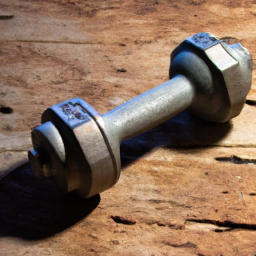In this article, we will discuss the importance of incorporating rest days into your weekly workout routine. You will learn why rest days are crucial for your overall fitness progress and how they help prevent injuries. We will also explore the benefits of rest days for muscle recovery and growth, as well as ways to make the most out of these days. By the end of this article, you will have a better understanding of why rest days are an essential component of any successful workout plan.
What are rest days?
Definition of rest days
Rest days are days designated in a workout routine where you intentionally take a break from intense physical activity and allow your body to recover and recharge. During a rest day, you give your muscles time to repair and rebuild, prevent overtraining, and take care of your mental and emotional well-being. Rest days are an essential component of any effective workout routine, as they can significantly impact your overall progress and performance.
Why rest days are necessary in a workout routine
Rest days are necessary in a workout routine for several reasons. Firstly, they allow your muscles to recover and repair themselves. When you exercise, you create small tears in your muscle fibers. Rest days provide the opportunity for these tears to heal, resulting in stronger and more resilient muscles.
Secondly, rest days prevent overtraining, which can lead to a plateau in performance, increased risk of injury, and decreased motivation. Overtraining occurs when you continuously push your body without giving it adequate time to rest and recover. By incorporating rest days into your routine, you ensure that you are not overexerting yourself and giving your body the time it needs to adapt to the physical stress of exercise.
Lastly, rest days provide mental and emotional rejuvenation. Intense workouts can place a lot of stress on your mind as well as your body. Taking a break from exercise allows you to relax, reduce stress levels, and maintain a healthy balance between physical activity and other aspects of your life.
Benefits of incorporating rest days
Muscle recovery and repair
One of the primary benefits of incorporating rest days is muscle recovery and repair. When you exercise, especially through resistance training or high-intensity workouts, your muscles undergo microdamage. This damage triggers a process called muscle protein synthesis, where your body repairs and rebuilds the damaged muscle fibers. Rest days provide the time necessary for this repair process to occur, resulting in stronger muscles and improved overall performance.
Prevention of overtraining
Another significant benefit of rest days is the prevention of overtraining. Overtraining, as mentioned earlier, can have detrimental effects on your progress, performance, and overall well-being. By giving yourself adequate rest and recovery time, you allow your body to adapt and respond to the stress placed on it during exercise. This prevents excessive strain on your muscles, joints, and nervous system, reducing the risk of injury and ensuring long-term progress.
Improved performance and strength
Incorporating rest days into your workout routine can actually improve your performance and strength. During periods of rest, your muscles have the opportunity to rebuild and become stronger. Additionally, rest days allow you to recharge mentally and physically, enhancing your focus and energy levels when you do return to your workouts. By striking a balance between exercise and rest, you set yourself up for consistent progress and improved overall athletic performance.
Mental and emotional rejuvenation
Rest days also play a crucial role in your mental and emotional well-being. Exercise releases endorphins, which are the “feel-good” hormones that contribute to a positive mood and reduced stress levels. However, constantly pushing yourself without taking time to rest and recover can lead to burnout and decreased motivation. Rest days allow you to step back, relax, and engage in activities that bring you joy and fulfillment outside of the gym. This mental and emotional rejuvenation ultimately enhances your overall well-being and ensures a sustainable and enjoyable fitness journey.
How to determine the right number of rest days
Listen to your body’s signals
Determining the right number of rest days depends on various factors, including your fitness level, training intensity, and personal preferences. It is crucial to listen to your body’s signals and pay attention to how it feels and responds to your workouts. If you experience excessive fatigue, muscle soreness that doesn’t subside, or a decrease in performance, it may indicate that you need more rest days in your routine.
Consider your workout intensity and duration
Another factor to consider is the intensity and duration of your workouts. If you engage in high-intensity or long-duration workouts, you may need more frequent rest days to allow your body ample time for recovery. On the other hand, if your workouts are less intense or shorter in duration, you may be able to incorporate fewer rest days.
Consult with a fitness professional
If you’re unsure about how many rest days you should incorporate into your routine, it can be helpful to consult with a fitness professional or personal trainer. They can assess your individual needs, goals, and current fitness level and provide recommendations tailored to your specific circumstances. A professional can also offer guidance on how to structure your routine to optimize rest and recovery while still making progress towards your fitness goals.
Best practices for utilizing rest days effectively
Active rest vs. complete rest
When it comes to rest days, there are two main approaches: active rest and complete rest. Active rest involves engaging in low-intensity activities that promote blood flow and muscle recovery without straining your body. These activities can include gentle yoga, walking, swimming, or light stretching. On the other hand, complete rest involves abstaining from any form of exercise or physical activity. Both approaches have their benefits, and the choice between them depends on personal preference and the specific needs of your body.
Engage in low-impact activities
On your rest days, it is beneficial to engage in low-impact activities that promote active recovery. These activities can help improve blood flow, enhance mobility, and alleviate muscle soreness. Some examples of low-impact activities to consider include swimming, cycling, Pilates, or gentle stretching exercises. These activities can aid in the recovery process while minimizing the impact on your muscles and joints.
Proper nutrition and hydration
Rest days are an excellent opportunity to focus on proper nutrition and hydration. Fueling your body with nutrient-dense foods and staying properly hydrated can support the recovery process and optimize your performance during your workout days. Aim to consume a balanced diet consisting of lean proteins, healthy fats, whole grains, and plenty of fruits and vegetables. Additionally, staying hydrated by drinking an adequate amount of water throughout the day is crucial for maintaining optimal bodily functions.
Sleep and recovery techniques
Getting enough sleep is essential for rest and recovery. Aim for seven to nine hours of quality sleep each night to allow your body to repair tissues, regulate hormones, and replenish energy stores. Additionally, you can incorporate various recovery techniques on your rest days, such as foam rolling, stretching, or using a massage tool to alleviate muscle tension and improve flexibility.
Common misconceptions about rest days
Rest days are not lazy days
One common misconception about rest days is that they are equivalent to lazy days. Rest days are far from being lazy; they are an integral part of a well-rounded workout routine. They allow your body and mind to recover, repair, and recharge, contributing to improved overall performance and progress.
Rest days do not hinder progress
Another misconception is that rest days hinder progress. In reality, rest days actually promote progress and improvements in physical performance. They allow your body the necessary time to repair and rebuild muscles, prevent overtraining, and reduce the risk of injury. Without adequate rest, your progress may stall, and you may experience decreased motivation and burnout.
Rest days do not lead to weight gain
Some individuals fear that taking rest days will result in weight gain. While it’s true that rest days may not burn as many calories as intense workout days, they are essential for maintaining a healthy and balanced lifestyle. The overall impact of rest days on weight management is minimal compared to the benefits they provide for muscle recovery, performance, and overall well-being.
Potential risks of neglecting rest days
Increased risk of injury
Neglecting rest days and continuously pushing your body to its limits can significantly increase the risk of injury. Overtraining can lead to overuse injuries, muscle imbalances, and joint problems. By giving yourself ample rest and recovery time, you allow your body to repair and strengthen itself, reducing the risk of chronic injuries and promoting long-term fitness and health.
Plateau in performance and results
If you neglect rest days and train excessively, you may experience a plateau in performance and results. Your body needs time to adapt to the physical stress of exercise and grow stronger. Without rest, you may find it challenging to make progress and reach your fitness goals. Incorporating rest days into your routine helps ensure continued improvements in strength, endurance, and overall performance.
Decreased motivation and burnout
Continuous intense exercise without taking adequate rest can lead to decreased motivation and burnout. Pushing your body beyond its limits without allowing it to recover can result in physical and mental exhaustion. This can ultimately affect your desire to exercise, making it more challenging to maintain a consistent fitness routine. By incorporating rest days, you prioritize your mental well-being and create a sustainable approach to fitness.
How to make the most of your rest days
Engage in active recovery exercises
On your rest days, consider engaging in active recovery exercises. These exercises are low-intensity activities that promote blood flow, increase mobility, and aid in muscle recovery. Examples of active recovery exercises include gentle yoga, light stretching, or going for a leisurely walk. These activities help maintain your body’s movement and flexibility without placing excessive stress on your muscles.
Focus on mobility and flexibility
Rest days provide an excellent opportunity to focus on mobility and flexibility work. You can use this time to incorporate exercises that improve your range of motion, joint mobility, and muscle flexibility. Dynamic stretches, yoga poses, and mobility drills can help increase your flexibility, reduce muscle stiffness, and enhance overall movement quality.
Stretching and foam rolling
Stretching and foam rolling are effective ways to target specific muscle groups, release tension, and aid in muscle recovery. On your rest days, allocate some time to stretch the major muscle groups, paying particular attention to areas that feel tight or sore. Foam rolling, also known as self-myofascial release, can help alleviate muscle knots and adhesions, promoting optimal muscle function and flexibility.
Meditation and mindfulness practices
Rest days are an excellent time to incorporate meditation and mindfulness practices into your routine. These practices promote relaxation, reduce stress levels, and enhance mental clarity. Take a few minutes to sit in a quiet space, focus on your breath, and allow your mind to unwind. Engaging in mindfulness can help recharge your mental and emotional batteries, leaving you refreshed and ready for your next workout.
Importance of balancing rest days with workout days
Finding the right balance for your body
Finding the right balance between rest days and workout days is crucial for optimal fitness and health. While rest days are necessary, it’s equally essential to engage in regular physical activity to maintain cardiovascular health, muscular strength, and endurance. Experiment with different workout and rest day schedules to find what works best for your body and individual needs.
Avoiding exercise addiction or obsession
Balancing rest days with workout days is also important to avoid exercise addiction or obsession. While physical activity is beneficial for overall well-being, becoming overly fixated on fitness can lead to an unhealthy relationship with exercise. By including rest days, you prioritize a holistic approach to health and fitness, promoting mental, emotional, and physical well-being.
Maintaining a sustainable fitness routine
Rest days are essential for maintaining a sustainable fitness routine. Over time, consistent exercise without adequate rest can lead to burnout, decreased motivation, and a higher likelihood of quitting altogether. Incorporating regular rest days allows your body to recover and recharge, ensuring that you can sustain your fitness journey for the long term.
Myths and misconceptions about rest days
Rest days do not equate to lack of dedication
One common myth about rest days is that they reflect a lack of dedication or laziness. However, rest days are not indicators of a lack of commitment; rather, they demonstrate an understanding of the importance of recovery for overall progress and performance. Rest days show that you are dedicated to taking care of your body and optimizing your fitness routine.
Rest days are crucial for long-term progress
Another misconception is that rest days impede progress. On the contrary, rest days are crucial for long-term progress and improvements in physical performance. Without ample rest, your body may struggle to repair and build muscle, leading to a plateau in results. By embracing rest days, you set yourself up for continuous growth and development in your fitness journey.
Rest days support overall health and well-being
Rest days are not just about physical recovery; they also play a significant role in supporting your overall health and well-being. By allowing yourself time to rest, recharge, and engage in activities unrelated to exercise, you prioritize your mental and emotional health. This balanced approach enhances your well-being, leading to a more sustainable and fulfilling fitness journey.
Conclusion
The importance of rest days in your weekly workout routine cannot be overstated. Rest days are essential for muscle recovery and repair, preventing overtraining, improving performance and strength, and rejuvenating your mental and emotional well-being. Determining the right number of rest days depends on factors such as your body’s signals, workout intensity and duration, and guidance from fitness professionals. Utilizing rest days effectively involves engaging in active or complete rest, low-impact activities, proper nutrition and hydration, and sleep and recovery techniques.
Rest days are often misunderstood, with common misconceptions suggesting that they are lazy, hinder progress, or lead to weight gain. On the contrary, neglecting rest days can result in an increased risk of injury, plateau in performance and results, and decreased motivation and burnout. Making the most of your rest days involves engaging in active recovery exercises, focusing on mobility and flexibility, incorporating stretching and foam rolling, and practicing meditation and mindfulness.
Balancing rest days with workout days is vital for finding the right equilibrium for your body, avoiding exercise addiction or obsession, and maintaining a sustainable fitness routine. Rest days do not equate to a lack of dedication; rather, they demonstrate a commitment to overall progress and well-being. Embracing rest days supports long-term improvements in performance, while also nurturing your overall health and happiness. So, find a rest day strategy that works for you and benefit from the physical, mental, and emotional advantages of incorporating rest days into your weekly workout routine.





